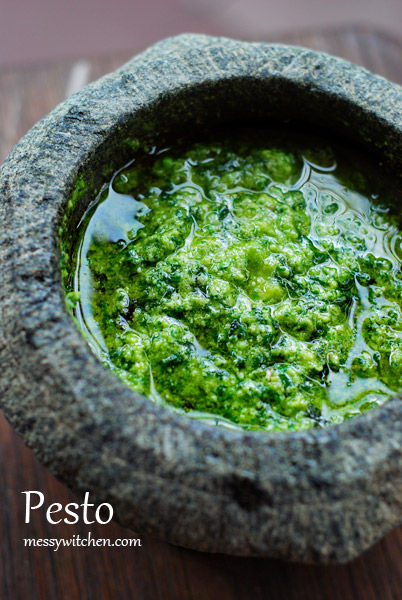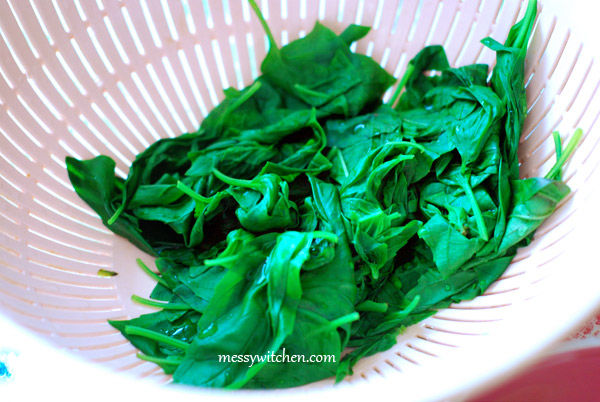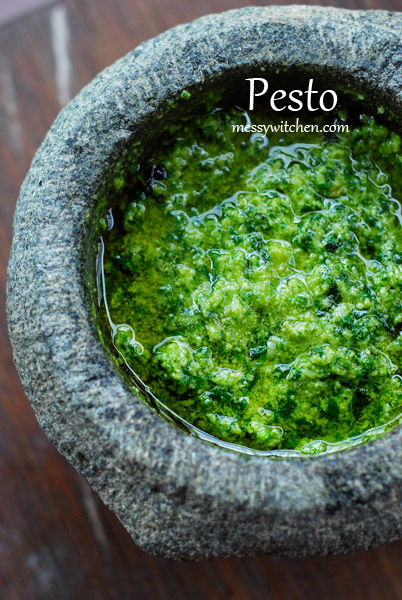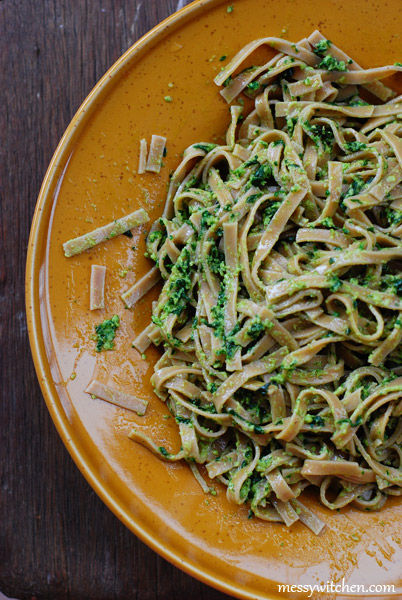I’ve never tasted pesto prior to year 2013 (yes, seriously!). The only time I eat pesto is the one made from my own kitchen. I’ve never tried pesto from restaurant therefore I cannot judge whether the one I made are true blue Italian taste. However I can assure you this pesto recipe is heavenly. Hehehe It’s adapted from Salt to Taste. Tsk I will also share my tip on how to make the basil stay green in this post. I dislike dark green (oxidized) basil.
Pesto is usually made from basil, garlic, pine nuts, olive oil and Parmigiano Reggiano. It’s a sauce hailed from Genoa (Liguria region of northern Italy). The word pesto means to pound and that’s how I made my homemade pesto; pounded with mortar and pestle. How do you eat pesto? You can use pesto in pasta, as pizza sauce, salad dressing or even toasted bread. For this recipe, I’m going to use the pesto for the pasta I bought from Venice.

Pesto made from mortar and pestle. 🙂
Let’s work the muscles!

To get a beautiful green on your basil, blanch them in boiling water for 5 seconds. This will give the basil a quick shock. Then remove the basil with a sieve and put in ice water or cold running water to stop the cooking. Squeeze dry the basil as much as you can.
When I first started making pesto, I was puzzled as to why my basil turned dark green or sometimes black when I’m pounding the leaves. Turns out it was oxidizing. Blanching the basil in boiling water for a mere moment will prevent this from happening.
Meanwhile if you’re planning to accompany the pesto with pasta, you can start boiling water for the cooking the pasta.

This is tagliolini ai funghi porcini (tagliatelle with porcini mushroom) bought from my 2012 Europe trip. In Venice to be precised. I’ve always wanted to find the perfect moment to pair this pasta with a good sauce. Now is the perfect time. To tell you the truth, this pasta expired on 2013. Hahaha
Toast pine nuts until the nuts become light golden (about 5 minutes). Remember to toss it frequently to prevent from burning. I always toast my pine nuts to bring out the flavour. I’ve made pesto with and without toasting the pine nuts and the result is very different. Non toasted pine nuts added to pesto is really dull.

In a mortar, pound the salt and pine nuts until smooth.

Add garlic and pound again until smooth.

Add some basil in the mortar and mash the ingredient up. Add some more basil little by little as you go pounding.

How do you know when you need to stop pounding? You stop when you have reached the texture/consistency you prefer. For example, I like my pesto roughly pounded. So here’s where I stop. You can pound until you get a smoother texture.

Now add the olive oil and mix with a spoon.

Finally add the Reggiano and mix well. That’s it!
For tips on how to refrigerate or freeze the pesto, refer to recipe below.

Creamy and oh so good!

This tagliolini ai funghi porcini was a perfect accompaniment with the pesto. Super yum!
Pesto With Mortar & Pestle
Adapted from Salt to Taste by Marco Canora
Serves 3-4
2 cloves garlic, peeled and slightly crushed
3/4 teaspoons coarse salt
1/4 cup pine nuts, toasted
3 cups fresh basil, tightly packed, rinsed
6-8 tablespoons extra virgin olive oil
1/2 cup Parmigiano Reggiano, grated
Method:
1. Blanch basil in boiling water for 5-10 seconds. Remove the basil with a sieve and immediately put in ice water to stop the cooking or you can put under cold running water like what I usually do. Squeeze the basil as dry as possible.
Note: Reason for blanching basil is to make your basil stay beautiful green. By blanching for few seconds, you’re giving the basil leaves a big shock therefore prevent it from turning dark green/black (oxidized).
2. In a mortar, add salt and pine nuts and pound until smooth.
3. Add garlic and pound until smooth again.
4. Now add basil little by little as you go while pounding the leaves.
5. Once you get the texture you prefer (I like mine roughly pounded), mix in the olive oil with a spoon (you can’t pound it anymore because the oil with fly in all directions). If you want to freeze the sauce, stop right here and freeze the pesto in a jar cover with a layer of olive oil. Because cheese doesn’t freeze well, you only add the cheese when you are serving the pesto after you have defrost the pesto.
Note: I’ve tried freezing finished pesto and they were still okay.
6. Finally add the cheese and mix well. That’s it.
I usually have a little leftover and refrigerate the pesto in a bowl with a layer of olive oil and cover with cling film.
Enjoy!




No Comments